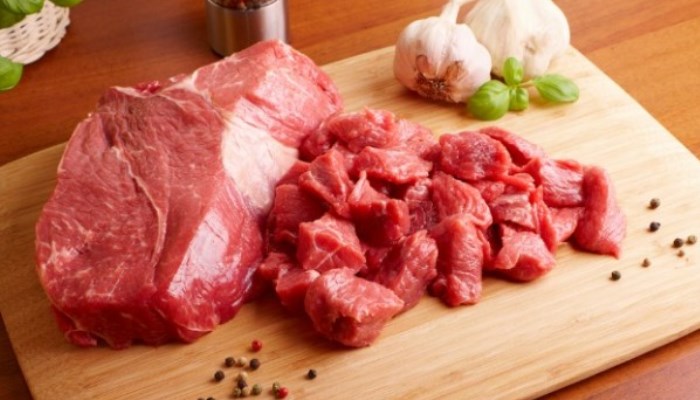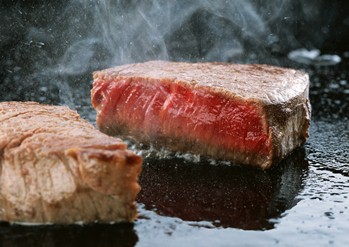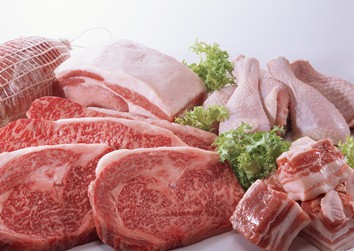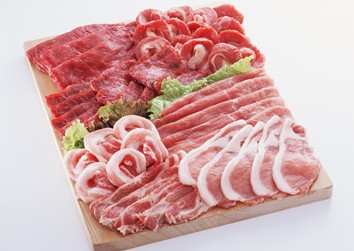
Red meat in traditional culinary terminology is meat which is red when raw and not white when cooked. Red meat includes the meat of most adult mammals and some fowl (e.g. ducks). In the nutritional sciences, red meat includes all mammal meat.
Gastronomic
In gastronomy, red meat is darker-colored meat, as contrasted with white meat. The exact definition varies by time, place, and culture, but the meat of adult mammals such as cows, sheep, and horses is invariably considered red, while chicken and rabbit are invariably considered white. The meat of young mammals such as milk-fed veal calves and sheep, and pigs is traditionally considered white; while the meat of duck and goose is considered red. Game is sometimes put in a separate category altogether (French viandes noires 'black meats').
Red meat does not refer to how well a piece of meat is cooked. Nor does it refer to its coloration after cooking. A cut of meat is red or white independent of whether it is served rare, or cooked until it is well-done.
Degree of cooking
Temperature (meat)
The amount of time a steak is cooked is based upon personal preference; shorter cooking times retain more juice, whereas longer steak cooking times result in drier, tougher meat but reduce concerns about disease. A vocabulary has evolved to describe the degree to which a steak is cooked. The following terms are in order from least cooked to most cooked:
Raw — Uncooked. Used in dishes like steak tartare, Carpaccio, gored gored, tiger meat and kitfo.
Seared, Blue rare or very rare — Cooked very quickly; the outside is seared, but the inside is usually cool and barely cooked. The steak will be red on the inside and barely warmed. Sometimes asked for as "blood rare" or "bloody as hell". In the United States, this is also sometimes referred to as 'Black and Blue' or 'Pittsburgh Rare'. It is common for chefs to place the steak in an oven to warm the inside of the steak. This method generally means 'blue' steaks take longer to cook than any other degrees.
Rare — (52 °C [125 °F] core temperature) The outside is gray-brown, and the middle of the steak is red and slightly warm.
Medium rare — (55 °C [130 °F] core temperature) The steak will have a fully red, warm center. This is the standard degree of cooking at most steakhouses, unless specified otherwise.
Medium — (60 °C [140 °F] core temperature) The middle of the steak is hot and red with pink surrounding the center. The outside is gray-brown.
Medium well done — (65 °C [150 °F] core temperature) The meat is light pink surrounding the center.
Well done — (71 °C [160 °F] and above core temperature) The meat is gray-brown throughout and slightly charred.
Overcook — (much more than 71 °C [160 °F] core temperature) The meat is dark throughout and slightly bitter.
Reduce potential cancer-causing compounds when grilling
- Several steps help prevent these compounds from forming or reduce your exposure to them.
- Choose lean red meat cuts when grilling to reduce the chance of flare-ups or heavy smoke, which can leave carcinogens on the meat.
- If grilling, cook over medium heat or indirect heat, rather than over high heat, which can cause flare-ups and overcook or char meat. - Limit frying and broiling, which also subject meat to high temperatures.
- Don’t overcook meat. Well-done meat contains more of the cancer-causing compounds. But make sure that meat is cooked to a safe internal temperature to kill bacteria that can cause food-borne illnesses. For steaks, cook to 145 to 160 degrees Fahrenheit; for burgers, cook to 160 degrees.
- Marinate. Marinades may reduce the formation of HCAs. Choose one without sugar, which can cause flare-ups and char the meat’s surface.
- Turn meat frequently. Use tongs or a spatula rather than a fork to avoid releasing juices that can drip and cause flare-ups. Do not press burgers with a spatula to release juices.
- Don’t grill as much meat. Instead of a steak, try a kabob that mixes meat, fruit and vegetables. Plant-based foods have not been linked to HCAs.
- Trim fat from meat before cooking, and remove any charred pieces before eating.
- Consider partially cooking meats and fish in the oven or microwave before finishing on the grill.
A style exists in some parts of North America called "Chicago". A Chicago-style steak is cooked to the desired level and then quickly charred. The diner orders it by asking for the style followed by the doneness (e.g. "Chicago-style rare"). A steak ordered "Pittsburgh rare" is rare or very rare on the inside and charred on the outside. In Pittsburgh, this style is referred to as "black and blue" (black, i.e. sooty on the outside, Blue rare on the inside).
charred. The diner orders it by asking for the style followed by the doneness (e.g. "Chicago-style rare"). A steak ordered "Pittsburgh rare" is rare or very rare on the inside and charred on the outside. In Pittsburgh, this style is referred to as "black and blue" (black, i.e. sooty on the outside, Blue rare on the inside).
As meat is cooked, it turns from red to pink to gray to brown to black (if burnt), and the amount of red liquid, myoglobin (not blood), and other juices decreases. The colour change is due to changes in the oxidation of the iron atom of the heme group in the myoglobin protein: raw meat is red due to myoglobin protein in the muscles, not hemoglobin from blood (which also contains a heme group, hence the color). Prior to cooking, the iron atom is in a +2 oxidation state, and bound to a dioxygen molecule (O2), with a red colour. As cooking proceeds, it loses an electron, moving to a +3 oxidation state, and coordinating with a water molecule (H2O), turning brown in the process.
Searing raises the meat’s surface temperature to 150°C, yielding browning via different reactions: caramelization of sugars, and the Maillard reaction of amino acids. Raised to a high enough temperature, meat blackens from burning.
What are some of the leanest cuts of red meat?
For the best red meat cuts, look for those with “loin” in the name: Sirloin tip steak, top sirloin, pork tenderloin, lamb loin chops.
Beef: Also look for round steaks and roasts, such as eye round and bottom round; chuck shoulder steaks; filet mignon; flank steak; and arm roasts. Choose ground beef labeled at least 95% lean. Frozen burger patties may contain as much as 50% fat; check the nutrition facts box. Some grilling favorites are high in fat: hot dogs, rib eyes, flat iron steaks, and some parts of the brisket (the flat half is considered lean).
Pork: Lean cuts include loin roasts, loin chops, and bone-in rib chops.
Nutrition
Red meat is a source of iron. Red meat also contains protein, levels of creatine, minerals such as zinc and phosphorus, and vitamins such as niacin, vitamin B12, thiamin and riboflavin. Red meat is the richest source of Alpha Lipoic Acid, a powerful antioxidant.
What is the average fat content of lean red meat?
Fully trimmed lean raw beef typically contains only 5% fat, fully trimmed lean raw pork only 4% fat and fully trimmed lean raw lamb only 8% fat. This compares well with a food such as cheddar cheese which contains an average of 34% fat.
How much red meat should I eat?
Opinions differ here, too. Most of the nutritionists that WebMD contacted suggested focusing on sensible portion sizes and lean red meat cuts, for those who choose to eat it.
Ask yourself these questions, recommends Alice Lichtenstein, DSc, professor of nutrition at the Human Nutrition Research Center on Aging at Tufts University.
Are you taking in more calories than you’re burning off?
Is red meat crowding out foods such as fruits, vegetables, and whole grains?
“People don’t need to give up red meat,” says Christine Rosenbloom, PhD, RD, a nutrition professor at Georgia State University. “They need to make better selections in the type of meat they eat and the portions.”
Government guidelines in MyPyramid suggest 5 to 6 1/2 ounces daily of protein from a variety of sources, including lean meats, nuts, and seafood. So if you’re planning on eating a burger for dinner, it should be a 3-ounce hamburger patty, about the size of a standard McDonald’s burger.
Health Benefits
There are innumerable health benefits of eating meat, to say, for example, it serves as a fabulous source of high quality proteins, which a single vegetarian food is not able to provide. It contains all the essential amino acids that the body requires.
single vegetarian food is not able to provide. It contains all the essential amino acids that the body requires.
The red meat contains very high quantities of iron, when compared with plant origin foods. 100 grams of Liver contains 6000 mcgm of iron as against 325 mcgm in 100-gram carrots. Read further to explore information about the advantages of eating meat…
The phosphorus content present in meat gets much more easily absorbed than that present in cereals and legumes. This is owing to the fact that cereals and legumes contain phosphorus, usually in the form of phytic acid that must be hydrolyzed before absorption. Meat also serves as the main source for the intake of vitamin B12.
Though meat is rich in nutrients, but, there are certain things that meat lacks in. It doesn't contain any kind of fiber, which helps to keep your digestive system in order. Also it is very high in saturated fats, thus it is recommended to eat meat, but in moderate quantities.
Preserved meats like ham, bacon, salami etc should be avoided, as they are very high in terms of fats, salts, nitrites and nitrates that are often held responsible for causing cancer. It is recommended to eat not more than 60-75 grams of meat per day and not more than thrice a week.
Negative Health Effects of Red Meat
Regardless, nutritionists hardly need more evidence about the potentially negative health effects of eating red meat. For starters, the saturated animal fat in red meat contributes to heart disease and atherosclerosis. Recent research also shows that frequent red meat eaters face twice the risk of colon cancer as those who indulge less often. Red meat is also thought to increase the risks of rheumatoid arthritis and endometriosis.
 There are plenty of health reasons to avoid eating red meat, and a higher risk of colon cancer is just one of them. The saturated animal fat found in red meat products contributes to heart disease and atherosclerosis. In addition, red meat can contain contaminants such as heavy metals, pesticides and undesirable environmental pollutants that tend to collect in the fat tissues of cows, which are absorbed into your body when you eat cow fat. And you can't eat red meat without getting some animal fat.
There are plenty of health reasons to avoid eating red meat, and a higher risk of colon cancer is just one of them. The saturated animal fat found in red meat products contributes to heart disease and atherosclerosis. In addition, red meat can contain contaminants such as heavy metals, pesticides and undesirable environmental pollutants that tend to collect in the fat tissues of cows, which are absorbed into your body when you eat cow fat. And you can't eat red meat without getting some animal fat.
Heart disease: Some red meats are high in saturated fat, which raises blood cholesterol. High levels of LDL cholesterol increase the risk of heart disease.
When it comes to cancer, the answer is not so clear. Many researchers say they do raise the risk, especially for colorectal cancer.
A recent National Institutes of Health-AARP study of more than a half-million older Americans concluded that people who ate the most red meat and processed meat over a 10-year-period were likely to die sooner than those who ate smaller amounts. Those who ate about 4 ounces of red meat a day were more likely to die of cancer or heart disease than those who ate the least, about a half-ounce a day. Epidemiologists classified the increased risk as “modest” in the study.
Red meat has been shown to increase the risk of bowel cancer. As research show that a diet low in red meat reduces the chance of Alzheimer's, it stands to reason that a diet rich in red meat will increase the chance. Red meat, if eaten to the extreme, can effect bone health and lead to a greater risk of osteoporosis. A diet that includes eating red meat each day can double your chances of rheumatoid arthritis. Red meat can cause high cholesterol. A study by Harvard medical school seems to suggest that more than 100g a day of red meat can increase the risk of breast cancer. The side effects of red meat can be severe.
Bowel cancer
A pan-European study of nutrition and cancer found that people who ate more than two 80g portions of red meat a week were 30 per cent more likely to develop bowel cancer than those who ate less than one portion.
Scientists are still unsure why there is an increased risk, but there is a theory that the compounds haemoglobin and myoglobin, found in red meat, trigger a process called nitrosation in the gut which in turn leads to the formation of cancer-causing compounds.
Processed meats such as sausages may also be risky because the cooking process can create carcinogenic compounds called heterocyclic amines.
Alzheimer's disease
Research has shown that a Mediterranean diet - low in red meat but rich in plant foods and fish - can reduce the chances of developing Alzheimer's by up to two-thirds.
Again, there is no firm theory on this. Researchers University of California Los Angeles (UCLA) suggested last month that red meat could be linked to a build-up of iron in the brain, causing the opposite effect of antioxidants; in effect, the brain rusts. The researchers suggest it may also explain why more men develop Alzheimer's, as men eat more red meat than women.
Bones
Too much red meat can have an adverse effect on bone health. The digestive process of protein leaves acid residues in the body that need to be neutralised with alkalising minerals - and these may be taken from the bones, leading to a higher risk of osteoporosis and other conditions. While green, leafy vegetables are high in calcium, red meat has a low level and can cause excess acid to form, creating bone problems for the future.
Arthritis
Eating red meat every day could double your risk of developing rheumatoid arthritis. Scientists believe that collagen, found in red meat, may trigger an immune system response, which may also affect the joints. Additives contained in processed meats may also play a part in the increased rate of the disease.
Cholesterol
Red meat is one of the first foods that doctors advise patients to stop eating if they are at risk of heart disease, because it contains high levels of dietary cholesterol. A build-up of cholesterol in the arteries can eventually stop blood flow and trigger heart attacks. However, it depends on the type of meat you are eating; lean red meat is relatively healthy - it is the fatty chops and burgers that are more risky. Red meat is also high in saturated fat, which has been linked to a range of cardiovascular problems, including high blood pressure.
Food poisoning
The Food Standards Agency has launched an investigation into the safety of red meat after research suggested that beef, lamb and pork are the cause of one in six outbreaks of food poisoning. Experts are to test samples to find out the amount of bacteria in them, although the problems are more likely to be linked to poor hygiene in the home than to standards at abattoirs.
Breast cancer
A study from the Harvard Medical School last week suggested that eating more than 100g of red meat a day could double the risk of a woman developing breast cancer. The risk was associated with young women who had not yet gone through the menopause. Experts said the increased risk may be down to the cancer-causing compounds created by cooking meat, or by excess iron levels.
The meat industry contends there is no link between red meat, processed meats, and cancer, and says that lean red meat fits into a heart-healthy diet. A meat industry spokeswoman criticized the design of the NIH-AARP study, saying that studies that rely on participants to recall what foods they eat cannot prove cause and effect. “Many of these suggestions could be nothing more than statistical noise,” says Janet Riley, a senior vice president of the American Meat Institute, a trade group.
![]()


































